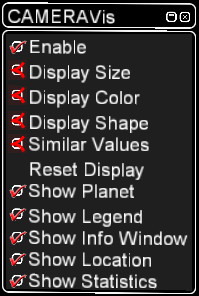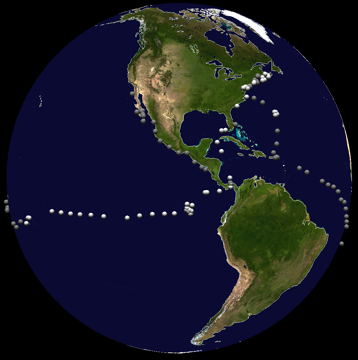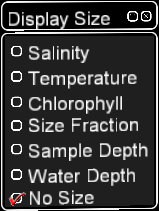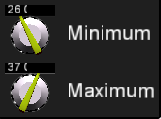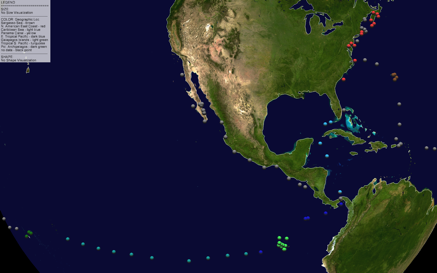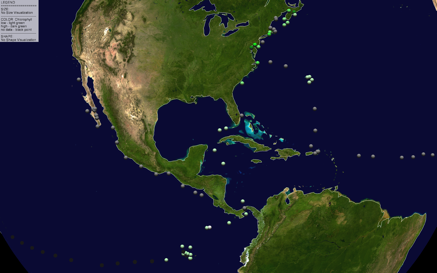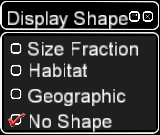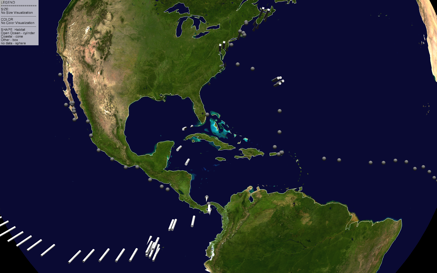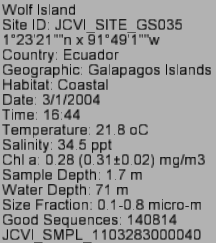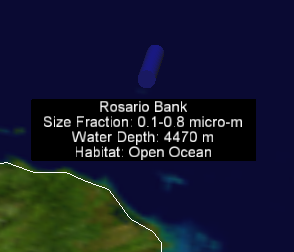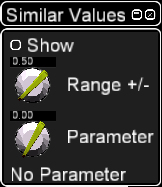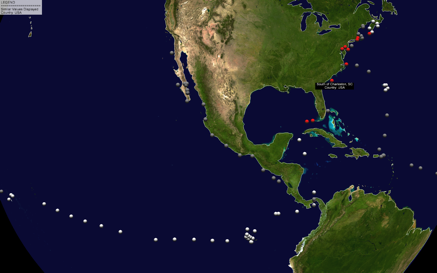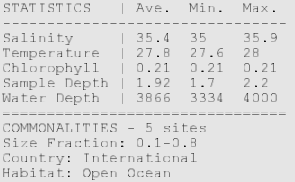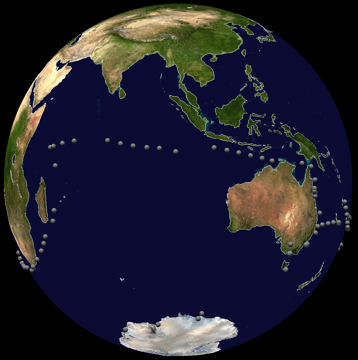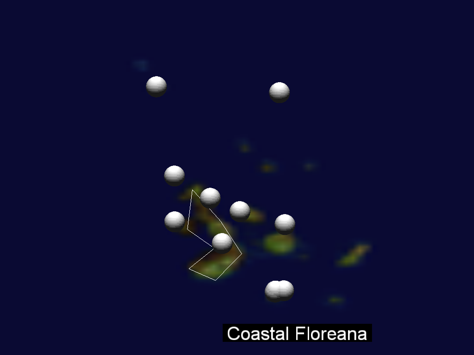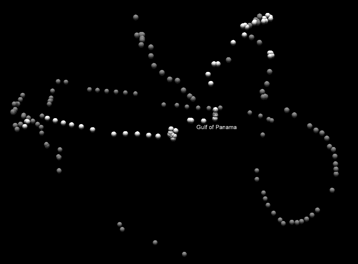CAMERA Meta-Data Visualization
This Wiki Page is a user-guide for the CAMERAVis Application.
Questions? Sara Richardson (serichardson@ucsd.edu)
Contents |
Getting Started
1. Run OpenCOVER.
2. Select 'CAMERAVis' from the COVER menu (opens CAMERAVis menu)
3. Select 'Enable' from the CAMERAVis menu.
Sample Sites (herein 'data points') are initially displayed as white, uniformly-sized spheres.
Quick Guide
1. Display Size, Color, and Shape to manipulate the data point. Representations explained in the legend.
2. Mouse-over/intersect a data point to get its location name and values for any parameters displayed.
3. Click on a data point to get all of the metadata available for the point.
4. Similar Values: select a parameter and a range, select a data point for comparison, distinguishes all relative points.
5. Statistics: select points for statistics, displays calculations/commonalities of all points selected.
Data Point Manipulations
Metadata values can be displayed by varying the size, color, or shape of the data points in a multitude of combinations.
Size
1. Select 'Display Size' from the CAMERAVis menu (opens Display Size menu).
2. Select the parameter to display (Salinity, Temperature, Chlorophyll, Sample Depth, Water Depth, or Size Fraction, ).
The data points will change in size (radius of sphere, height of cone/cylinder/box) according to the value of the selected parameter. Lower values correspond to smaller-sized data points; higher values correspond to larger-sized data points. This is explained on screen in the legend.
3. Use the 'Min'/'Max' dials to adjust the range of metadata values over which the size will vary.
Data points with metadata values lower than 'Min' are all displayed as the smallest-sized; data points with metadata vales higher than 'Max' are all displayed as the largest-sized. Those data points with metadata values within the selected range will vary across a size gradient according to their metadata values. By default, the 'Min'/'Max' are initially set at values that exclude outliers.
4. At any time, select 'No Size' from the Display Size menu to return all data points to the uniform size.
Color
1. Select 'Display Color' from the CAMERAVis menu (opens Display Color menu).
2. Select the parameter to display (Salinity, Temperature, Chlorophyll, Sample Depth, Water Depth, Size Fraction, Habitat, Geographic Location, or Country).
The data points will change in color differently according to the selected parameter and the value/category. Habitat, Country, Geographic Location, and Size Fraction have different colors for each possible category. Salinity (yellow), Chlorophyll (green), Sample Depth (blue), and Water Depth (blue) run on one color across a color gradient where low metadata values are whiter and high metadata values are fuller in color. The Temperature color gradient runs from blue (low) through white to red (high). This is explained on screen in the legend.
3. Use the 'Min'/'Max' dials to adjust the range of metadata values over which the color will vary where a color gradient is in use.
Data points with metadata values lower than 'Min' are all displayed as the whitest in color; data points with metadata vales higher than 'Max' are all displayed as the darkest in color. Those data points with metadata values within the selected range will vary across the parameter's color gradient according to the data points' metadata values. By default, the 'Min'/'Max' are initially set at values that exclude outliers.
4. At any time, select 'No Color' from the Display Size menu to return data points to white.
Shape
1. Select 'Display Shape' from the CAMERAVis menu (opens Display Shape menu).
2. Select the parameter to display (Size Fraction, Habitat, or Geographic Location).
The data points will change their geometric shape according to the category of the parameter. Data points will be either a box, cone, or cylinder or a sphere if there is no metadata category for that data point. The shape representation is explained on screen in the legend.
3. At any time, select 'No Shape' from the Display Size menu to return data points to spheres.
Reset Display
1. Select 'Reset Display'
Resetting the display will return all data points to white, uniformly-sized spheres.
Information Display
There are three different ways to learn generally/specifically about the information represented on the globe.
Legend
Select 'Show Legend' from the CAMERAVis menu to show/hide the legend. The legend explains what the data point manipulations represent, and updates itself when any changes to the display are made. The default for 'Show Legend' is 'on' (checked).
Information Window
Select 'Show Info Window' from the CAMERAVis menu to show/hide the information window. The information window displays all metadata available for the last data point clicked on. The default for 'Show Info Window' is 'on' (checked).
Location Tip
Select 'Show Location' from the CAMERAVis menu to show/hide the Location tip. The tip displays the location name, as well as the values/categories for any displayed parameters, of the moused-over/intersected data point.
Interactive Features
There are different ways to interact with the data points to compare specific sets of multiple points.
Similar Values Display
1. Select 'Similar Values' from the CAMERAVis menu (opens Similar Values menu). The default is 'off' (unchecked).
2. Choose (click) a data point to compare against all others.
3. Use the 'Parameter' dial to choose a parameter to look for similarities with. The default is 'No Parameter'.
4. If the selected parameter is salinity, temperature, chlorophyll, sample depth, or water depth, use the 'Range' dial to choose a range for which metadata values will be close enough to that of the selected data point to be highlighted.
5. Select 'Show' from the Similar Values menu to highlight data points with metadata values that are within range or metadata categories matching that of the selected data point. The legend will explain specifics of the display.
Statistics
1. Select 'Statistics' from the CAMERAVis menu (Statistics window opens). The default is 'off' (unchecked).
2. Choose data points to be included in the Statistics window. Selected points are indicated with a translucent sphere (surrounding it if it a sphere, or at the data point's base if it is another shape).
The window will update after each newly selected point, displaying average, maximum, and minimum metadata values of the selected data points and commonalities amongst all of the selected data points. If none of the selected data points have a value for a certain parameter, the statistics are displayed as '--'.
Miscellaneous
The gray data points do not contain metadata (other than location name, geographic coordinates, time, and date) and thus will not change during data point display manipulations.
Flying into an indistinguishable clump of data points causes points to become relatively smaller, in effect separating them apart into separate, defined data points.
Select 'Show Planet' from the CAMERAVis menu to show/hide the planet. Data points remain. Default is 'on' (checked).
Uncheck 'Enable' from the CAMERAVis menu to remove planet, data points, and all windows.
Config Variables
_scaleSize - (float) Determines how big the font and sample sites are. Should correspond to cover->getScale() at the optimal zoom (varies 0.03 to 1.5).
MINSIZE, MAXSIZE - (float) cutoffs for the size function. Those values above MAXSIZE will revert to it, and vice versa with MINSIZE(~25, ~120).
windowWidth, windowHeight - (float) resolution of the display (i.e. 1920, 1080).
shapeScale - (float) Determines how tall the shapes (cone/box/cylinder) are in comparison to spheres (~5-10).
GOSFile, GOSFile2 - (address of text file) Links to the text files containing the metadata.
recenter - (bool) make 'true' if the world's center stays in one place. Moving rotates world, scale changes size.
